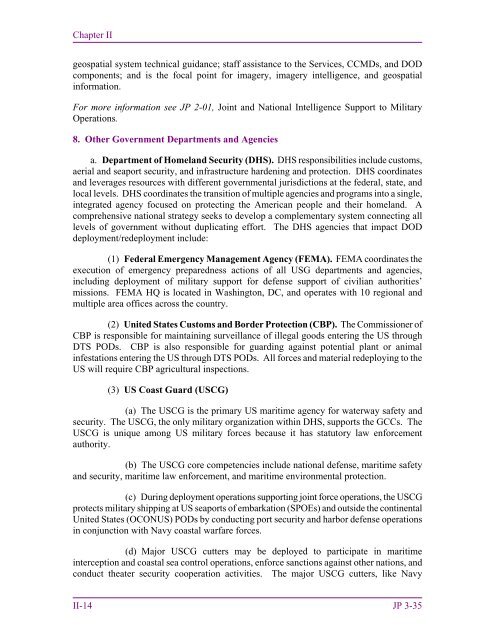7dmGW2vqk
7dmGW2vqk
7dmGW2vqk
You also want an ePaper? Increase the reach of your titles
YUMPU automatically turns print PDFs into web optimized ePapers that Google loves.
Chapter II<br />
geospatial system technical guidance; staff assistance to the Services, CCMDs, and DOD<br />
components; and is the focal point for imagery, imagery intelligence, and geospatial<br />
information.<br />
For more information see JP 2-01, Joint and National Intelligence Support to Military<br />
Operations.<br />
8. Other Government Departments and Agencies<br />
a. Department of Homeland Security (DHS). DHS responsibilities include customs,<br />
aerial and seaport security, and infrastructure hardening and protection. DHS coordinates<br />
and leverages resources with different governmental jurisdictions at the federal, state, and<br />
local levels. DHS coordinates the transition of multiple agencies and programs into a single,<br />
integrated agency focused on protecting the American people and their homeland. A<br />
comprehensive national strategy seeks to develop a complementary system connecting all<br />
levels of government without duplicating effort. The DHS agencies that impact DOD<br />
deployment/redeployment include:<br />
(1) Federal Emergency Management Agency (FEMA). FEMA coordinates the<br />
execution of emergency preparedness actions of all USG departments and agencies,<br />
including deployment of military support for defense support of civilian authorities’<br />
missions. FEMA HQ is located in Washington, DC, and operates with 10 regional and<br />
multiple area offices across the country.<br />
(2) United States Customs and Border Protection (CBP). The Commissioner of<br />
CBP is responsible for maintaining surveillance of illegal goods entering the US through<br />
DTS PODs. CBP is also responsible for guarding against potential plant or animal<br />
infestations entering the US through DTS PODs. All forces and material redeploying to the<br />
US will require CBP agricultural inspections.<br />
(3) US Coast Guard (USCG)<br />
(a) The USCG is the primary US maritime agency for waterway safety and<br />
security. The USCG, the only military organization within DHS, supports the GCCs. The<br />
USCG is unique among US military forces because it has statutory law enforcement<br />
authority.<br />
(b) The USCG core competencies include national defense, maritime safety<br />
and security, maritime law enforcement, and maritime environmental protection.<br />
(c) During deployment operations supporting joint force operations, the USCG<br />
protects military shipping at US seaports of embarkation (SPOEs) and outside the continental<br />
United States (OCONUS) PODs by conducting port security and harbor defense operations<br />
in conjunction with Navy coastal warfare forces.<br />
(d) Major USCG cutters may be deployed to participate in maritime<br />
interception and coastal sea control operations, enforce sanctions against other nations, and<br />
conduct theater security cooperation activities. The major USCG cutters, like Navy<br />
II-14 JP 3-35







